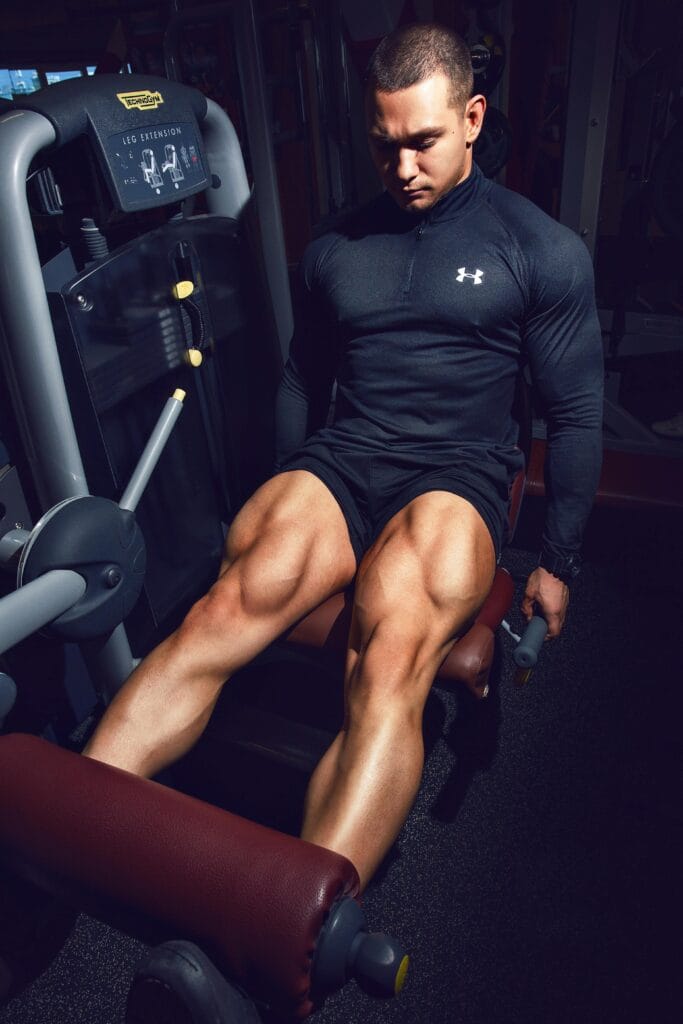FREE SHIPPING OVER $50
Want Bigger Glutes and Quads? Science Reveals the Exact Rep Ranges That Actually Work

You’ve been putting in the work at the gym. You’re doing your squats, your lunges, and your hip thrusts. But for some reason, your glutes and quads just aren’t growing the way you want them to. You see people on social media with incredible lower body development, and you wonder what their secret is. Is it a different exercise? A magical supplement? The truth is, the most common mistake people make isn’t about what they’re doing, but how they’re doing it.
For years, fitness has been dominated by bro-science and guesswork. We’ve all heard conflicting advice about rep ranges: “high reps for tone,” “low reps for strength,” and a lot of confusion in between. But science has finally given us a definitive answer. Researchers have uncovered the exact rep ranges and training methods that actually trigger muscle growth, or hypertrophy, in your glutes and quads. This article will break down the proven principles of muscle building and give you a clear, science-backed roadmap to get the results you’ve been working so hard for.
The Science of Muscle Growth: Beyond Just Lifting
Before we dive into the numbers, it is essential to understand why muscles grow. It is not just about showing up and lifting weights. The process of muscle hypertrophy is driven by three main mechanisms, and the best training programs target all of them.
- Mechanical Tension: This is the most crucial factor for muscle growth. Mechanical tension is the force placed on your muscle fibers as you lift a weight. When you perform an exercise with enough load, you create tension that signals your body to adapt and build bigger, stronger muscle fibers to handle that load next time. This is why progressive overload—the gradual increase of stress on the muscle—is non-negotiable for anyone who wants to see real growth.
- Metabolic Stress: This is the “pump” sensation you feel when your muscles are burning. As you perform multiple repetitions, metabolic byproducts like lactate and hydrogen ions build up. This stress on the muscle fibers also triggers a cellular response that promotes growth. While metabolic stress is not as powerful as mechanical tension, it is a key secondary driver of hypertrophy.
- Muscle Damage: This refers to the microscopic tears in your muscle fibers that occur during intense exercise, leading to delayed onset muscle soreness (DOMS). While once considered the primary driver of growth, science now shows that muscle damage is a less significant factor. The body repairs these tears and rebuilds the muscle fibers stronger, but it is the tension that truly signals the need for growth.
The Rep Ranges That Actually Work: A Scientific Breakdown
For years, the fitness industry has oversimplified the role of rep ranges. But the truth is, each range serves a specific purpose in building muscle. The most effective programs combine these ranges strategically.
1. The Strength Range (1-5 Reps)
This is the domain of heavy lifting. When you are performing sets in this rep range, your goal is not to get a pump but to build raw strength. This range is all about mechanical tension. While it does not directly cause the most muscle growth on its own, it is foundational. By getting stronger in this range, you will be able to lift heavier weights in the hypertrophy range, which will, in turn, lead to greater muscle growth. This is especially true for compound movements like squats and deadlifts, which are crucial for building glutes and quads.
2. The Hypertrophy Sweet Spot (6-12 Reps)
This is the gold standard for muscle growth. This rep range strikes the perfect balance between high mechanical tension and significant metabolic stress. You are lifting a heavy enough weight to signal your muscles to grow, while also performing enough reps to get a satisfying pump. To maximize your results in this range, you must train close to failure. The last few reps should be challenging and slow down significantly. That is when you are truly stimulating the muscle fibers to grow. This is the rep range where you will spend the majority of your time when trying to build bigger glutes and quads.
3. The Endurance/Metabolic Stress Range (15+ Reps)
While this rep range is often dismissed for hypertrophy, science shows it has a valuable place in a well-rounded program. The lightweight means you are not getting a lot of mechanical tension, but the high volume creates a massive pump and significant metabolic stress. This can be used as a finishing move at the end of a workout to add volume or to help you push through a plateau.
Applying the Science: Building Your Glute and Quad Routine
Now that you understand the science behind rep ranges, you can apply it to your training. For bigger glutes and quads, a balanced approach that incorporates all three ranges is the most effective strategy.
For Glutes: The Ultimate Muscle
The glutes are a powerful muscle group that responds incredibly well to different stimuli. To maximize their growth, you need to use a variety of exercises that target them from different angles.
- Heavy Compound Lifts (Strength Range: 4-6 reps): Start your workout with a heavy compound movement to build foundational strength. The barbell hip thrust is perfect for this, as it places a massive load on the glutes and creates significant mechanical tension at the top of the movement.
- Hypertrophy Builders (6-12 reps): Follow your heavy lift with exercises in the hypertrophy range. Romanian deadlifts are excellent for this, as they load the glutes in a stretched position. Other great options include lunges, cable kickbacks, and glute-focused leg press.
- Metabolic Finishers (15-20+ reps): End your workout with a high-rep finisher to create a deep burn. Banded hip abductions, glute bridges, or reverse hyperextensions with light weight are perfect for this.
For Quads: The Powerhouse
The quads are a dense muscle group that can handle a lot of volume. To build them, you need to focus on movements that create a deep stretch and tension at the bottom of the exercise.
- Heavy Compound Lifts (Strength Range: 4-6 reps): Start with the king of all quad exercises: the barbell squat. The squat puts your quads under heavy mechanical tension and is the best way to build overall leg strength. Other great options include the hack squat or leg press.
- Hypertrophy Builders (8-12 reps): Follow your heavy lift with high-volume work. The leg extension is perfect for this, as it isolates the quads and allows you to push to failure. Other great options include front squats and Bulgarian split squats.
- Metabolic Finishers (15-20+ reps): End with a high-rep, high-burn exercise like leg extensions or bodyweight squats to failure.
The Missing Pieces: What Rep Ranges Can’t Do Alone
Knowing the right rep ranges is a huge step, but it is not the only thing you need for growth. To truly unlock your potential, you must also prioritize these three non-negotiables:
- Nutrition: Muscles cannot grow without fuel. To build muscle, you need to be in a caloric surplus (eating more calories than you burn) and consume adequate protein (aim for 1 gram of protein per pound of body weight).
- Recovery: Muscles are torn down at the gym and built back up outside of it. Prioritize sleep and give your body the rest it needs to repair and grow stronger.
- Progressive Overload: Remember, the goal is always to get stronger. Once an exercise feels easy in a certain rep range, it is time to increase the weight, add a rep, or increase the volume.
Conclusion
The frustration of working hard without seeing results is a feeling many of us know. But the science is clear: you do not have to guess at the gym anymore. By understanding the principles of muscle hypertrophy and applying the right rep ranges to your glute and quad routine, you can move from frustrating plateaus to consistent, visible growth. By focusing on mechanical tension, metabolic stress, and smart programming, you will finally see the powerful, well-developed glutes and quads you have been working so hard for.
Related Articles
- This 12-Minute Yoga Routine Reverses Bone Loss Better Than Walking—Doctors Are Stunned
- Men Over 50 Are Building Muscle Faster Than Ever—Here’s the Science Behind the Surge
- Struggling With Tight Hips? These 5 Moves Help You Stay Strong and Mobile as You Age
- This Core Exercise Looks Easy—Until You Try It. Here’s How I Finally Made It Work
- He’s 63, Ripped, and Defying Aging. What He Told Me About Muscle Blew My Mind—You Need to Hear This
- Squats Hurting Your Knees? These 4 Fixes Changed Everything for Me



